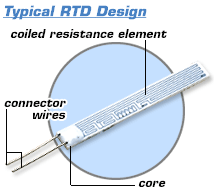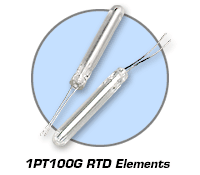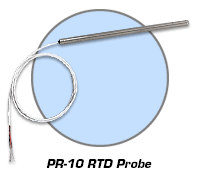
|
 |
Resistance Temperature Detectors / RTD / RTDs
What is a Resistance Temperature Detector? Resistance Temperature Detectors (RTD), as the name implies, are sensors used to measure temperature by correlating the resistance of the RTD element with temperature. Most RTD elements consist of a length of fine coiled wire wrapped around a ceramic or glass core. The element is usually quite fragile, so it is often placed inside a sheathed probe to protect it.
The RTD element is made from a pure material whose resistance at various temperatures has been documented. The material has a predictable change in resistance as the temperature changes; it is this predictable change that is used to determine temperature.
|
Common Resistance Materials for RTDs:
Platinum (most popular and accurate)
Nickel
Copper
Balco (rare)
Tungsten (rare)
|
|

|
| Benefits of Using an RTD
|
The RTD is one of the most accurate temperature sensors. Not only does it provide good accuracy, it also provides excellent stability and repeatability.
Most OMEGA standard RTDs comply with DIN-IEC Class B. The accuracy of an OMEGA standard RTDs is shown in the
table on the right.
RTDs are also relatively immune to electrical noise and therefore well suited for temperature measurement in industrial environments, especially around motors, generators
and other high voltage equipment.
|
Accuracy for Standard OMEGA RTDs
Temperature
°C | Ohms | °C |
| -200 | ±0.56 | ±1.3 |
| -100 | ±0.32 | ±0.8 |
| 0 | ±0.12 | ±0.3 |
| 100 | ±0.30 | ±0.8 |
| 200 | ±0.48 | ±1.3 |
| 300 | ±0.64 | ±1.8 |
| 400 | ±0.79 | ±2.3 |
| 500 | ±0.93 | ±2.8 |
| 600 | ±1.06 | ±3.3 |
| 650 | ±1.13 | ±3.6 |
| 700 | ±1.17 | ±3.8 |
| 800 | ±1.28 | ±4.3 |
| 850 | ±1.34 | ±4.6 |
|
| Styles of RTDs
|
RTD Elements
The RTD element is the simplest form of RTD. It consists of a piece of wire wrapped around a ceramic or glass core.
Because of their compact size, RTD elements are commonly used when space is very limited.
|
 |
RTD Surface Elements
A surface element is a special type of RTD element. It is designed to be as thin as possible thus providing good contact
for temperature measurement of flat surfaces.
|
 |
RTD Probes
The RTD probe is the most rugged form of RTD. A probe consists of an RTD element mounted inside a metal tube, also known as a
sheath. The sheath protects the element from the environment. OMEGA offers a wide variety of probes in various configurations.
|
 |
RTD Terms
- » RTD (Resistance Temperature Detector)
- An acronym for resistance temperature detector or device. A resistance temperature detector
operates on the principle of the change in electrical resistance in wire as a function of temperature.
- » RTD Element
- Sensing portion of the RTD which can be made most commonly of platinum, nickel, or copper. OMEGA features two
styles of elements: wire wound and thin film.
- » RTD Probe
- An assembly composed of an element, a sheath, a lead wire, and a
termination or connection. The standard OMEGA™ RTD probe is made with a 100 ohm platinum European curve
element (alpha = 0.00385).
- » Platinum RTD
- Also known as Pt RTD, Platinum RTD's are typically the most linear,
stable, repeatable, and accurate of all RTD's. Platinum wire was chosen by OMEGA because it best
meets the needs of precision thermometry.
- » Thin Film RTD
- Thinfilm RTD's are made up of of a thin layer of a base metal embedded into a ceramic substrate and trimmed to produce the desired resistance value.
OMEGA RTD's are made by depositing platinum as a film on a substrate and then encapsulating both.
This method allows for the production of small, fast response, accurate sensors. Thin film elements conform to the European curve/DIN 43760 standards and the 0.1% DIN standard tolerance.
- » Class A RTD
- Highest RTD Element tolerance and accuracy, Class A (IEC-751), Alpha = 0.00385
- » Class B RTD
- Most Common RTD Element tolerance and accuracy, Class B (IEC-751), Alpha = 0.00385
- » Aplha .00385 Curve
- European Curve meets 0.1% DIN standard tolerance and conforms to the DIN 43760 standard
- » Wire Wound
- The standard RTD elements used in OMEGAs probe assemblies are made of 99.99% pure platinum wire wound about a ceramic or glass core
and hermetically sealed within a ceramic or glass capsule.
|
|


